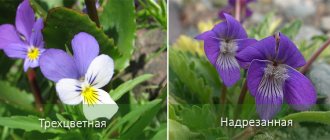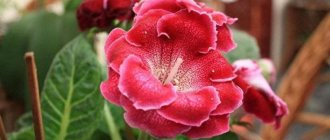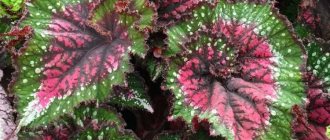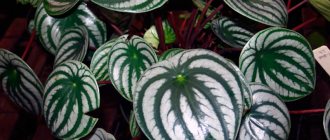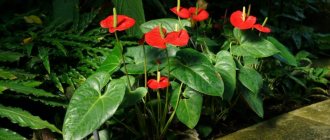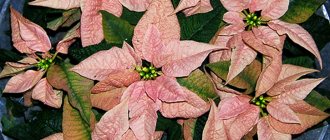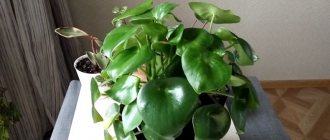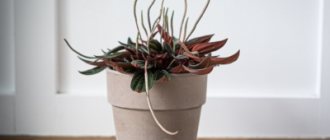Botanical description
A perennial from the pepper family, an epiphyte that grows on rotten wood .
- What is another name? Peperomia wrinkled earned its name due to the similarity of the leaves to peppers. In Brazil, the plant is called dwarf pepper.
- Latin name . It sounds like Peperomia Caperata, and the genus name comes from the Greek words peperi (pepper) and homoios (resemblance).
- History of origin. Peperomia Caperata was first identified and described in 1958.
- Description of appearance. The leaf blade is fleshy and wrinkled. The color is most often dark green. The petioles are long, slightly ribbed. The height of the plant does not exceed 30 cm. The root system is represented by nodules or creeping rhizomes.
- Geography of habitat. Peperomia is native to Brazil.
Pruning and replanting
To give the plant a beautiful, bushy shape, it is pruned. You need to cut off weak shoots from the top with garden shears. It is also necessary to remove wilted leaves. It is better to prune for young peperomia.
During the first three years of growth, the flower will require replanting. This procedure is performed quite often. Peperomia, which is transplanted annually, grows rapidly during this period. After 3 years of growth, this procedure can be carried out once every 2 years.
The transplant is performed in March or April. It is during this period that peperomia begins to actively grow. She feels cramped in her old potty. There is no need to replant after purchase. This is only necessary for those plants whose pot dimensions do not correspond to the size of the bush.
The choice of soil should be taken very seriously. The substrate should be loose and include nutritional supplements. They may contain peat, humus or sand. If the soil is dense and heavy, peperomia will not be able to develop a full-fledged root system. You should also take care to create high-quality drainage. This will protect the plant from rotting roots.
The pot for the Lilian variety should be small and shallow. If the flowerpot is too large, the flower will not have its characteristic decorative effect. Every year the diameter of the pot should be increased by literally a couple of centimeters.
You need to pour drainage material into the bottom of the flowerpot. The substrate is poured on top. Peperomia is installed in it. The base of the stem does not deepen. After completing the work, it is necessary to water the soil abundantly.
Photo
You will see a photo of a flower:
Possible problems in growing
The plant is susceptible to insects and infections.
When the air is very dry, spider mites infest. A web appears on the stems between the nodes, the leaves wither and fall off. To rid a perennial of a pest, you need to wipe the flower with a soapy sponge. Also spray with a mixture of water and 0.15% Actellik solution in a proportion of 1 ml per 1 liter of water.
Spider mite
Sometimes thrips appear due to high temperatures and low humidity. Colonies are concentrated on the leaves below. Light dots form at the top. The plant must be sprayed with insecticides.
For your information! Sometimes the flower is affected by diseases. Its roots and root collar may rot. This occurs due to fungal infections that form due to soil compaction or excessive watering. In this case, the plant is transplanted into new soil and the amount of watering is reduced.
Home care
- Temperature. Stability is the optimal strategy when selecting temperatures that are comfortable for peperomia. These are heat-loving plants that do not like either heat or cold. They feel most comfortable in stable “room” temperatures with an average of about 18 degrees Celsius.
Attention! In cold weather, it is recommended to maintain the temperature at least 16°, optimally up to 23°, otherwise the leaves will turn yellow and crumble. With the onset of spring, it grows well at 22-25°; it can be placed on a loggia or balcony.But it should be protected from drafts and sudden temperature changes.
It is important to prevent the substrate in pots from overcooling, since the rhizome most often suffers from temperature fluctuations. That is why it is not recommended to place the plant on cold surfaces.
- Watering. In cold weather, peperomia should be watered in the following mode:
- Each subsequent watering begins only when the substrate is completely dry.
Water for irrigation should be soft and warm.
- Experienced plant growers recommend standing water for at least three days.
- Watering with warm water prevents the soil from overcooling.
- Light. Peperomia feels good both in partial shade and in diffused light. Remember that it is dangerous to place the plant in direct sunlight, there is a high probability of getting burned! In winter, it is recommended to purchase special lamps for lighting, otherwise the petioles and leaves will weaken and become crushed.
- Priming. The plant is demanding on the quality of the substrate. More than anything else, the plant is afraid of dampness, so it makes sense to buy only loose, airy and water-permeable mixtures. The ideal combination is soil made from rotted leaves interspersed with sand and peat. And store-bought mixtures for succulent culture are also suitable.
- Trimming. Suitable for young individuals.
When removing part of a plant, it is recommended to make the cut at a height not exceeding five cm from the ground level. Don't forget to leave a couple of lower leaves. Young shoots will appear from the pruned plant, which can be rooted if desired. Reference. As new stems develop, they are also pinched or pruned, resulting in dense foliage. Only large varieties need pruning. Pruning increases the level of bushiness and thanks to this procedure, the plant has an excellent appearance. - Feeding. When feeding, it is important to observe seasonality. In winter, peperomia does not need fertilizers, which cannot be said about summer. In order for the plant to remain healthy and make you happy, it is better to choose complex fertilizers, then there is a chance not to overdo it when feeding. It is recommended to fertilize every two weeks.
- Pot. It is best to choose a classic container; the height should be greater than the diameter, since drainage is provided for the plant. The pot should not allow air to pass through; it is better to buy ceramic pots with a drainage hole at the bottom.
- Transfer. During the first three years, the plant needs to be replanted once a year, then growth slows down, so you can replant the plant every 2-3 years.
Pay attention to the roots, if they stick out from the hole - you cannot do without replanting. The best time to transplant is spring. Choose a pot that is not deep, form a bottom from drainage, no more than 6 cm. Expanded clay, brick, and charcoal are ideal for drainage. Then the plant must be placed in the center and sprinkled with earth, after which the top layer of soil must be compacted. - Wintering. The plant feels comfortable at a temperature of 18 degrees Celsius, in bright light. In winter, you should be especially careful to ensure that the soil does not overcool and not to overdo it with watering.
Watering is carried out with a small amount of water. You should also not overdo it with humidity. The ideal humidity level is no more than fifty percent; it is in such conditions that the plant looks beautiful and healthy. The plant is calm about lowering humidity , so you don’t have to spend money on an air humidifier.
All large-leaved peperomias, in addition to standard procedures, require periodic wiping of the leaves with a damp sponge to remove dust.
Peperomia care features
Peperomia corrugata is one of the most unpretentious houseplants, so even a novice gardener can handle caring for it. However, this flower cannot grow on its own, so it is important to understand what conditions are most suitable for peperomia. Like other house plants, shrubs of the Perucaceae family need regular watering, good lighting, temperature and humidity, as well as protection from pests. In addition, you need to figure out how to replant peperomia in order to propagate the flower.
Lighting and optimal placement of a flower pot
Despite the fact that peperomia is native to an area with a tropical climate, the shrub tolerates shade well and does not require constant bright lighting. Therefore, the window sill of an east or west window will be an ideal place to place a flower pot. Whereas on a southern window with intense light, the leaves of the plant will turn yellow and fade. It should be taken into account that flower varieties with burgundy and multi-colored leaves tolerate partial shade more easily than green ones.
Persistent shade tolerance of Peperomia corrugata does not mean that it does not need light at all. Elongated petioles will be evidence that the plant does not have enough light. This problem can be easily dealt with by moving the pot to another, more illuminated place.
Regularity of watering peperomia
The tropical shrub loves water, but the small root system of peperomia does not tolerate excess moisture. Therefore, excessive watering can lead to the death of the flower. In summer, the frequency of watering should be 2-3 times a day; in winter, during the dormant period, once a week is enough.
The best way to water is a tray filled with water. Then the plant will not take more moisture than it needs. It’s even better to put sand or small pebbles in the tray. Such measures will help maintain the required level of humidity.
Air temperature and humidity
Peperomia feels comfortable in a room whose temperature ranges from 22-24 degrees. The plant can live and grow with a slight increase in this indicator; one strong heat above 27 degrees leads to the fact that the leaves begin to turn yellow and dry out. This can be avoided by spraying peperomia, as it loves moist air. In summer and winter, when the central heating radiators are running, you need to do this regularly - several times a week. If the humidity in the room does not fall below 45-50%, spraying may not be carried out.
A container of water placed near the plant pot also helps solve the problem of low air humidity. It is especially important to place such a container on the windowsill if there are hot radiators under the window. This will help maintain the required level of humidity, the peperomia will feel comfortable and grow as a healthy plant.
Feeding and fertilizing the flower
At the beginning of spring, after a long period of hibernation, peperomia shriveled needs feeding. Fertilizers added to the soil will nourish the plant with vitamins and beneficial microelements for further active growth. As a rule, they are used in liquid form by adding them to water for irrigation.
You can choose suitable products for feeding at a flower shop, where a qualified seller will recommend the best way to fertilize peperomia. It is important that the fertilizing liquid does not contain acid, but contains nitrogen and phosphorus. With proper care and the right fertilizer, a healthy bush can bloom over time.
Thus, caring for peperomia corrugata includes the same basic rules and features as many other house plants. By devoting time and attention to tropical shrubs, the gardener will be able to achieve good results and grow a truly beautiful plant.
Reproduction
The attractive appearance of the plant and its decorative effect compel true lovers to breed peperomia in all possible ways:
- By cuttings. It is easy to propagate by cuttings with leaves.
- To do this, select a short cutting up to four cm in length and cut the shoot from the mother plant with a sharp knife.
- Next, treat the cut with activated carbon.
- Then, to root, place the cutting in damp sand or moss, you can also use water for these purposes, but please note that the maximum immersion depth cannot exceed more than five mm. Within three weeks, roots appear.
- Seeds.
- To propagate a plant by seeds, they need to be placed in jars with sand and humus.
- To speed up the germination of the container, close the lids and keep at a temperature of 24 degrees.
- Periodically, the contents of the jars must be moistened.
- When the sprouts have two leaves, you can move the plants to a container with soil.
- Next, you can plant them in pots.
- Custom. The plant is also easy to propagate using a bush - just divide the root system and transplant it into another container. After which we will get a new plant.
Other popular varieties
In addition to Peperomia Lilian, domestic gardeners grow other varieties of the plant. About 30 species that grow in the wild can thrive even in a small pot of soil. The most popular species in our country include peperomia wrinkled, blunt-leaved, magnolia-leaved, Rosso, etc. They differ in shape, leaf size, and inflorescences.
Peperomia blunt-leaved can reach a height of 40 cm. Its rounded leaves are covered with a waxy coating. The leaf cuttings are thick. The creeping plant is Peperomia capita. Its shoots reach 22 cm in length. Can be grown in an ampel form or as a ground cover flower.
Peperomia look quite impressive: magnolia-leaved and round-leaved. In the first variant, the leaves have an oval shape. They have stripes on the surface. The color of the veins is dark. In some cases, there are light yellowish spots on the leaves. The round-leaved variety looks impressive. Its leaves are very small (up to 1 cm). They cover the shoots, forming a dense bush.
Peperomia corrugata is a very small plant. The bush grows to a height of only 10 cm. The leaves are heart-shaped. They rise on pink cuttings. The foliage has a velvety appearance.
Chisel-shaped peperomia is distinguished by its original shape of foliage (similar to a crescent). It blooms with small green buds. The foliage resembles pea pods.
A relatively tall plant is the clusielifolia peperomia. It can grow up to 50 cm in height. The leaves are also quite large and succulent. Their size can reach 15 cm. The leaf blades are purple in color.
A striking plant is the Rosso variety. On the fleshy leaves the blades are very bright. They can even be confused with inflorescences.
This is not a complete list of peperomia growing in the homes of our compatriots today. Each gardener chooses the optimal plant variety for himself.
Bloom
The flowering time of the plant will be in the summer. Inflorescences begin to form, which can be seen among the leaves. At this time, the plant needs watering and spraying. Experienced flower growers recommend getting rid of flower stalks at the stage of their formation, since flowering takes away resources from the bush, which can cause peperomia to become less dense.
Important! There are often cases when, after flowering, peperomia sheds part of its stems and its leaves fall off.
Companion plants
These houseplants are ideal for growing in groups - so you can create a brilliant display by mixing several Peperomia colors and textures.
Peperomia are considered very suitable for bottle gardens or indoor terrariums as they grow slowly and therefore take a long time to outgrow their homes.
Companion planting helps improve plant growth by promoting flower blooms, rapid growth, and longer harvest times. Christmas cactus, peace lily, and dracaena are good companions for peperomia. Insect repellent plants may not grow well with peperomia as they can inhibit plant growth.
Diseases and pests
If not cared for properly, the plant gets sick. Violation of the irrigation system, temperature regime and cooling leads to the falling of leaves and the appearance of dark spots. When there is a high amount of moisture, the leaves begin to rot. Direct sunlight causes burns.
Mites, mealyworms, scale insects, and nematodes usually attack weak plants. To get rid of them, just treat the plant with fungicides and replant it in steamed soil. It is much easier to prevent a disease than to treat it.
When and how does it bloom
Peperomia - flower care at home
Next, it’s worth finding out how the crop blooms and at what time this happens.
- Types of flowers. Peperomia flowers are visually similar to lilies, hence the name. But on each long red-brown peduncle many small inflorescences appear, gathering in a bunch.
- Flower shapes. The inflorescences have an oblong shape, resembling a cob. Small flowers look like flags, which are placed on one peduncle.
- Flowering period. The crop blooms in late spring and early summer. The buds do not emit aromas; their value is less significant than the leaves. Flowering occurs throughout the summer.
- Changes in care during the flowering period. Care during the flowering period is slightly different, namely the need for abundant watering of the crop. The flowering process takes a lot of energy, and as a result the bush becomes less dense.
Note! Sometimes the stems need to be cut to help the plant branch better. The affected leaves are also removed. Timely cleaning increases the perennial's resistance to diseases.
Similar flowers
- Sansevieria Trifasciata Prain is an evergreen herbaceous perennial.
- Saintpaulia Pink Sensation is a perennial herb with wrinkled, fleshy leaves.
- Calathea striped is an indoor plant with large, dense leaves.
- Saffron calathea is a versatile plant with yellow flowers.
Peperomia rugosa is thermophilic and easily propagated by bunches of leaves. It grows not only in loose soil, but also in hydroponic culture. The plant will decorate any collection. You can safely trust the plant even to beginners. If all the described conditions are met, peperomia will delight you with beauty for a long time!
Types of peperomia with photos and names
Velvety peperomia (Peperomia velutina)
This species comes from Ecuador and is represented by herbaceous perennial plants. The dark red, straight, pubescent stem is located vertically. The length of the petioles of the leaf blades is about 10 mm. The alternate rounded leaves are green. On the front surface of the leaf blade there are 5–7 greenish veins from the base to the top. In different varieties, the foliage can be either glossy or covered with short hairs. During flowering, spikelet flowers grow on the tops of branches or from leaf axils, the length of which is about 70 mm.
Peperomia clusiifolia
In nature, this perennial herbaceous plant is found in the tropical forests of Venezuela. Dense sessile petiolate alternately arranged leaf plates have a dark green color with a slight reddish tint. The leaves are about 15 centimeters long and up to 8 centimeters wide, their edges are purple, the base is wedge-shaped, and the upper part is most often blunt.
There is a variety of variegata, its leaf blades are not very dense and have a variegated color. The edge of the plate is pale red, closer to the middle the leaf becomes yellow, and near the vein it is dark green. This species does not occur in natural conditions.
Reddish Peperomia (Peperomia rubella)
This species is a herbaceous perennial branched plant with thin red stems. Small oval-elongated foliage on the stem is arranged in fours opposite each other, its front surface is green and its back surface is red. The species is highly decorative.
Peperomia maculosa
This plant comes from the mountain forests of tropical latitudes of South America. The species is represented by herbaceous perennial plants. There are many brown spots on the surface of the green stems. Glossy, long, ovoid leaf blades grow from the root, are about 20 centimeters long, and are colored dark green with white veins. Long inflorescences are brown in color.
Peperomia marmorata
In nature, the species is found in Brazil; it is represented by a low herbaceous perennial plant that forms a lush bush. The round, heart-shaped green leaf blades are decorated with pale brown veins that extend from the base of the leaf and are directed towards its upper part.
Creeping Peperomia (Peperomia serpens)
This epiphytic perennial plant comes from the swampy forests of the tropical latitudes of the American continent. Its stems are vertical, hanging or recumbent. The shape of the petiole leaf plate is flattened-ovate, with a heart-shaped notch at its base. The color of alternate foliage can be variegated or green. The species is cultivated as an ampelous plant.
Peperomia blanda
In nature, the species is found in South American tropical forests. It is represented by epiphytic perennials. The stems are densely covered with hairs. Small oval leaf plates are arranged oppositely on the stems in 3 or 4 pieces, their width is about 15 mm, and their length is up to 40 mm. The back surface of the plate is red, and the front surface is green.
Gray Peperomia (Peperomia incana)
In nature, the species is found in Brazil. It is represented by herbaceous perennial plants or subshrubs, the height of which is about half a meter. The stems are densely covered with hairs. Dense green leaf plates taper slightly towards the top and have a rounded shape, they reach up to 50 mm in diameter, the surface is covered with white hairs.
Silver Peperomia (Peperomia argyreia)
In nature, the species is found in Brazil and Venezuela. It is represented by terrestrial perennial or stemless epiphytic plants. The petioles of the foliage reach about 100 mm in length, they grow from the root and are colored red. The bare, fleshy and dense leaf plates have 7–9 green veins, between which there are whitish stripes.
Peperomia caperata
This species is native to Brazil. The height of the bush is only about 10 centimeters. Petiolate leaf plates, like rosettes, grow from the root. Their ribbed petioles are pinkish in color. The plate is covered with many veins, which are strongly convex on the back surface and concave on the front surface. The foliage color is green and the veins are brown. During flowering, which occurs in summer, white spikelets grow. This species is grown both as a flowering plant and as an ornamental foliage plant.
Peperomia obtusifolia
In nature, the species is found in the tropical latitudes of South America. This herbaceous perennial can grow both on trees and on the ground. There is pubescence on the surface of the stems. Dense, fleshy, petiolate, alternately arranged leaf plates are dark green in color and have an ovoid shape (expanding towards the top of the leaf and narrowing towards the base). The length of the foliage is about 8–12 centimeters, and the width is up to 4–5 centimeters. Flower growers cultivate many varieties and forms.
PEPEROMIA - Peperomia Home care
How to replant peperomia
Shrubs are transplanted for the purpose of propagation. Therefore, you can use several available methods for this. Most often, leaf or stem cuttings are used, as well as the method of dividing the bush. You can also try to grow peperomia using seeds, however, this option is the most difficult and is suitable for professional, experienced gardeners.
Another reason for the need for replanting is the growth of peperomia and the limitation of its size due to the volume of the pot. This procedure should be carried out no more than once every 2 years. Peperomia grows slowly and reaches small sizes even in adulthood. Therefore, the plant does not need a large pot, but several containers will have to be replaced throughout the life of the flower.
Before replanting peperomia, it is necessary to prepare suitable soil for the shrub. The optimal soil composition includes equal parts of turf and leaf soil, as well as a small addition of sand and peat. The soil should be light and breathable, with good air permeability. Drainage must be laid out at the bottom of the pot. When watered through a tray, this system will provide the necessary amount of moisture for Peperomia shriveled.
The procedure for propagating a flower using a leaf includes several stages. First, you need to cut a suitable leaf. It should not be the oldest or the youngest, so it is cut out from the center. This should be done with a sharp stationery knife. Secondly, the cut leaf must be inserted into the pre-prepared soil at a slight angle. The container with the cutting should be covered with a transparent cap made of plastic or glass, creating something like a small greenhouse.
Thirdly, every day for 2-3 weeks the cap must be removed and the plant must be given access to air. After this, it will be possible to remove it altogether and allow the wrinkled peperomia to grow further under normal conditions. By that time, the leaf should have taken root, after which it can be transplanted into a permanent pot and wait for other leaves to appear.
Thus, propagation and replanting of the plant is not particularly difficult. If you are careful and create greenhouse conditions for the wrinkled peperomia for the first time, the sprout will definitely survive and become a full-fledged plant.
general information
Lily is a beautiful bulbous plant with dozens and hundreds of different varieties. Depending on the species, the height of the stem can vary from 15 cm to 2.5 m. And almost always these are large funnel-shaped flowers of 6 petals up to 14 cm in diameter.
Lilies come in almost any shade except blue. Flowering times also differ, so much so that with the right combination of species, the garden will bloom continuously from late spring until autumn. The leaves are quite long and ovate, and buds form from the lower plates, which then grow into an independent bulb.
Another interesting feature is that lilies can cross-pollinate with each other and unexpectedly change color. The root system grows from the bulb, and in most cases the roots are perennial. Some varieties are also covered with thin stem roots for better nutrition and also for stability.
Photo: pocvetam.ru
Conditions for growing at home
Before you bring peperomia into your home, read the tips on growing it from professional gardeners.
Lighting and ventilation
The crop should not be exposed to direct sunlight, so the best location for it is window sills in eastern and western rooms. If the window faces south, the peperomia should be shaded or moved to the back of the room.
In winter you cannot do without sources of artificial lighting. Electric lamps will extend daylight hours. In addition, during the winter months, Peperomia lilian should be protected from draft winds. However, in summer the pot can be taken out into the fresh air. After dusk, bring it indoors, as low night temperatures and cool winds can harm the flower.
Air temperature and humidity
Optimal temperatures range from +16 to +18°C. The main thing is that the temperature does not rise above 25 degrees above zero. In order for the plant to always look well-groomed and healthy, it is important to guarantee its humidity of at least 35%. During the summer months, periodically mist the crown with distilled water. To prevent dust from accumulating on vegetative organs, wipe the leaves with a damp sponge from time to time.
Did you know? The fastest growing plant on the planet is bamboo. During the day it increases in height by 0.75–0.9 m.


